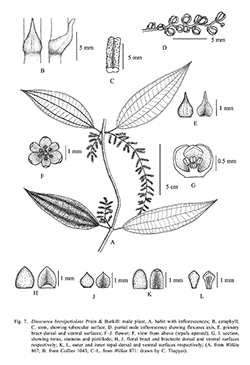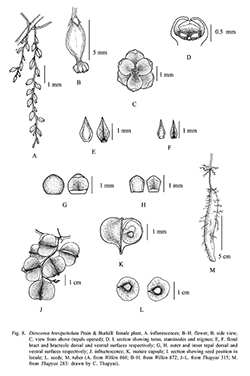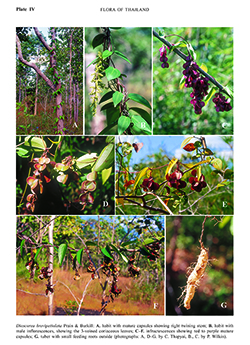e-Flora of Thailand
Volume 10 > Part 1 > Year 2009 > Page 19 > Dioscoreaceae > Dioscorea
4. Dioscorea brevipetiolata Prain & Burkillwfo-0000389351
[ex Craib, Bull. Misc. Inform. Kew 1912: 407. 1912, nom. nud], J. & Proc. Asiat. Soc. Bengal. 10: 38. 1914; R.Knuth in Engl., Pflanzenr. 4, 43: 287. 1924; Prain & Burkill, Bull. Misc. Inform. Kew 1927: 241. 1927; in Fl. Indo-Chine 6: 729. 1934; Ann. Roy. Bot. Gard. (Calcutta) 14(2): 286. 1938; Hô, Câyco Viêtnam 3, 2: 929. 1993; Wilkin, Thapyai & Chayamarit, Kew Bull. 62: 252. 2007. Fig. 7, 8; Plate IV.
Accepted Name : This is currently accepted.
Description : Climber to 5 m. Tubers 1 per growing season, with withering tuber of previous season, 10–15 by 1.6–3 cm, cylindric to clavate, deeply vertically buried. Indumentum present at least on older stems as fine tuberculae giving a rough texture. Stems 0.5–4 mm in diam., twining to the right, annual, unarmed, terete. Leaves simple, opposite, blades coriaceous, elliptic-ovate to broadly ovate, 3-veined, margins entire, base narrowly cuneate to truncate, apex acute to acuminate; petioles 0.4–2 cm long; cataphylls 2.4–3.5(–10) by 1.5–3.2 mm, ovate to broadly ovate, apex acute; lateral nodal organs and bulbils absent. Inflorescences pendent, axes terete and shallowly angled, partial inflorescences flexuous, spicate, tepals free, fleshy in texture, on a discoid torus; male inflorescences compound, 1(–2) per axil, partial inflorescences 1–3–4) per axil; female inflorescences simple or compound, compound inflorescences 1 per axil; simple/partial inflorescences 1–4(–6) per axil; peduncles 8–15 mm long, axes 4–15 cm long. Male flowers with outer tepals 0.8–1.3 by 0.7–1.1 mm, broadly ovate, inner tepals (Fig. 7L) 0.7–1.2 by 0.4–0.6 mm, narrowly obovate to obovate, stamens 6. Female flowers as Fig. 8B–H. Capsules as Fig. 8J, K, Pl. 4C–F, 12–16 by 21–30 mm. Seeds 2.5–3.3 by 2.5–3 mm, flattened-ovoid to lenticular, wings 10–15 by 8.5–14 mm, extending all around seed margin.
Thailand : NORTHERN: Phitsanulok (Nam Tok Chat Trakan); NORTH-EASTERN: Sakon Nakhon (Nonthapthang, Phu Phan), Nakhon Phanom (Phu Langka), Nong Bua Lamphu, Nong Khai (Phu Wua), Mukdahan (Phu Hin Pra Turp), Maha Sarakham (Phayakkhaphum Phisai), Khon Kaen (Wat Khao Suan Kwang); EASTERN: Chaiyaphum (Phu Lang Ka), Nakhon Ratchasima (Bua Yai), Roi Et (Ban Kok Kaeo, Phanom Prai), Ubon Ratchathani (Phu Chong Na Yoi, Pho Sai), Amnat Charoen (Chanuman); CENTRAL: Saraburi (Sam Lan); SOUTH-EASTERN: Chon Buri (Sri Racha, Nong Khao – type: Kerr 2047, lectotype -K, isolectotype -BM, Khao Khiao), Chanthaburi, Trat (Ko Chang, Ko Sa).
Distribution : Vietnam, Cambodia.
Ecology : Open areas in deciduous dipterocarp and mixed deciduous forests mostly on sandstone, rarely in evergreen forests, 20–600 m alt. Flowering: July–December; fruiting: October–January.
Vernacular : Man nok (มันนก)(Phitsanulok); man thian (มันเทียน)(Chon Buri, Sakon Nakhon); man dong (มันดง)(Trat)
Uses: The tubers are edible, and are usually boiled without preparation other than peeling. It is known as man thian (มันเทียน) or candle yam because the shape and colour of the tuber resembles a wax candle.
Conservation Status: IUCN red list category LC (IUCN 2001). Needs research on sustainable levels of harvesting from wild populations.
Notes: This species is easily recognised by its tubercular stems (especially towards the stem bases), short petioles (not more than 2 cm long), and 3-veined, coriaceous leaf blades. Immature capsules are often deep purple or magenta, especially in full sun. Prain & Burkill (1938) separated the species into two varieties, var. vera with a warty stem and var. laevicaulis with a smooth stem. However, we have seen no specimens which lack stem tuberculi.



